Was Your Riding Instructor Wrong?
So, I’m not going to lie. I’m in a bit of a mood. I’m growing really tired of all the news reports and all the posts on Reddit of riders running wide in corners and either running into oncoming traffic or running off the road. Running wide in corners is one of the top causes of motorcycle crashes.
So you know what. I’m going to be a little bit more candid with this video. I’m just going to come out and say it. There is a good chance that your riding instructor was wrong. In fact, over the years, I’ve received, literally, hundreds of emails from riders lamenting the fact that their riding coach was requiring they ride in a manner that made them feel less in control and at more risk.
So, here it comes: Ready? Slow, Look, Press and Roll is wrong. Flat out. It should never be taught as a riding technique. It’s been getting people hurt and killed since the idea was first published in the ‘70s.
And lets be honest, how many other things from the ‘70s are at all relevant today? Seriously. I don’t understand… What is this obsession with the way things used to be. The ‘70s were terrible. The food was awful. The power was always going out. The music sucked, the movies sucked, TV reception was mostly unwatchable and even the parenting was awful because everyone was drunk and smoking cigarettes. We know so much more now than we did in the ‘70s!
Look, Slow, Look, Press and Roll only really works on very gentle bends with lots of visibility; you know, super easy corners like a freeway on-ramp. And I’ll be honest. I use it in those situations. But those kinds of corners are not at all challenging. We can see. It’s not especially tight, there’s not a lot of lean angle and, truthfully, it’s a lot of fun to rally through those easy corners. And we need to be adaptable; able to adjust our techniques to the conditions. Slow, Look, Press and Role does work in some circumstances and in those circumstances; for sure, use it.
But those are not the kinds of corners that we’re running wide in. It’s those tight corners, corners without much visibility, corners that get a lot tighter half-way through or downhill corners. Those are the kinds of corners that every single one of us, myself included, has totally screwed up. So, for the rest of this video when I talk about a corner, I’m not talking about the easy ones. I’m talking about the challenging ones. The technical corners that we’ve all struggled with.
The way Slow, Look, Press and Roll has been taught for almost fifty years, including in some high-performance riding schools, is that we do all of our braking while the bike is straight up and down. Slow. Get off the brakes and then snap a countersteer. Press. Then accelerate through the entire corner. Roll.
Some programs go so far as to put little pieces of tape on the ground to tell you where to get off the brakes, snap your countersteer and begin accelerating. Three pivotal operations in the space of a scrap of tape.
One argument will often be that getting onto the gas early stabilizes the chassis. Well, yeah, throwing away the brakes causes the front of the bike to spring back up, and snapping a countersteer puts the bike and the tires into a tizzy fit. For sure, you gotta figure out a way to stabilize that chassis. But, don’t you think it would be better to find a method of turning that doesn’t completely upset the bike’s stability?
So, lets go over this. Motorcycles change direction by leaning. We all know this. So we’re riding along, and we turn the handlebar to the right. We press forward with our left hand, our right hand comes back towards us. We’re steering. But motorcycles only have two wheels. So it leans away from the direction of the steer. Now, after the bike starts leaning, the front wheel will hinge back over to the left, and the motorcycle will basically begin steering through the corner.
The bicycle really exaggerates these handlebar movements. But once leaned over, the front tire is absolutely steering. And we find ourselves leaning to the left and turning left. Countersteering. Basically, we are managing the gyroscope.
On a motorcycle at speed, these handlebar movements are really subtle and we may not even realize they are taking place unless we are paying a lot of attention, and we may make small steering and countersteering adjustments to keep the bike’s lean angle where we need it.
So far so good, but here’s where Slow, Look, Press and Roll really falls apart. It tells us we need to accelerate through the entire corner. Well, what happens? If we’re accelerating, all that centrifugal force is pushing the bike back up and to the right. So the only way we can maintain our lean and our turn, is to add more and more countersteer to add more and more lean to counteract the acceleration pushing us up and over to the other side. The faster we go, the more lean we need to keep the bike balanced against the centrifugal force.
Here’s the next problem. Speed equals radius. Right? But, there are practical limits to how fast we can go through a given corner based on how tight it is. We must go slow through tight corners, and we can go faster through gentle corners. Accelerating through an entire corner makes it harder to stay on the road or in our lane because going faster increases the radius of the corner.
Here’s another problem. It keeps getting worse. Grip comes from weight. Right? Barely touch the ground with your foot and try to slide it, now put a lot of weight on your foot and try to slide it. Grip comes from weight. So, as we’re accelerating, the bike’s weight is shifting to the rear. taking weight away from the front tire. You know, the tire that actually makes the bike change direction. As we accelerate, it’s harder for the front tire to steer the motorcycle because it has less weight, less grip, to keep it stuck to the road.
And it gets worse even still. As your forks compress and extend, it changes the geometry of our bike. Compressed forks decrease trail, which makes the bike want to change direction, while extended forks increase trail, which makes the bike want to go straight. In simple terms, as soon as we start to accelerate in a corner, the bike’s geometry makes the bike stop turning and start to run wide.
Think of it like this. How many of life’s problems come down to a simple communication problem? The same is true with our motorcycles. We are communicating with the bike and it’s giving us feedback. When we use the throttle we are telling the bike we want to go straight, so if we’re adding throttle while trying to turn, we are giving our bike mixed messages. It’s no different than all those people scream and yell at their dog to come to them, then scold the dog when he does. Come Here! Bad Dog! Mixed messages.
So, at its core, the entire concept of accelerating through the entire corner is a giant miscommunication. It pits countersteering against the laws of physics. Seriously, I can’t tell you how many times I’ve watched a student ask their riding coach about what they should do if they enter a corner too fast. And the instructor will say “just countersteer harder”.
Because that’s the solution, right? Just lean more – Because we all know that lean angle and grip is infinite. I mean, it’s impossible to run out of lean angle or grip, right?. I’ll bet none of us have ever touched a footpeg in a corner before.
Or sometimes the instructor will say “You should have entered the corner slower” Well great. I’ll just roll back my time machine and give it another go. Fat lot of good that does me now that I’m in the middle of the corner.
And we haven’t even gotten into all the problems that arise if there is something unexpected in the middle of the corner, like a stalled car, a 2×4 or a pile of gravel. Transitioning from acceleration to braking in the middle of the corner is fairly risky because it’s a pretty delicate process.
So yeah, Slow, Look, Press and Roll works fine in gentle corners with lots of visibility, and lots of grip; but what happens if the corner is tighter than we expected, or there is less grip that we expected, or we are having to lean way more than we are comfortable with? Or what if that downhill corner is more downhill or tighter than it looked at the top of the hill? We Run Wide. If we’re lucky, we get away with it. If we’re unlucky we get hurt, sometimes fatally. And this is what has to stop. We need to abandon Slow, Look, Press and Roll as it’s been taught since the the time of disco balls and butterfly collars”
So, what’s the solution? What‘s the better way? It’s called trail braking. And, to cut off the keyboard cowboys at the pass, trail braking is not going into a corner too hot and then grabbing the brakes. That’s not trail braking, that’s “oh shit” braking, and we can all agree it’s a terrible technique. Oh Shit braking causes the motorcycle to stand up and it can cause a loss of grip at the front tire. Trail Braking and Oh Shit Braking are two very different things.
Trail braking is still doing the majority of our braking before we enter the corner then we gently trail off the front brake until the motorcycle is turned and we can see our exit. In simplest terms, it’s gently slowing until we can see our exit. Most of us do it in our cars. Hell, my mom, who is the most conservative driver in the world, trail brakes to the apex of every corner in her Nissan Juke.
With trail braking there is no need to stabilize the chassis because we never upset the chassis to begin with. With trail braking we are extremely unlikely to run wide because we can simply add and subtract small amounts of front brake pressure to put the bike exactly where we want it. With trail braking, we have significantly more control, more grip on the front tire and we are significantly reducing risk because instead of adding speed and inertia and energy to a potentially bad situation, we’re slowing down. And I don’t know about you, but I dont’ think slowing down is scary. Going faster and leaning more than I am comfortable with, well, that scares the hell out of me.
Listen, I was recently speaking with someone who has been teaching the high performance version of Slow, Look, Press and Roll at the racing level for well over a decade. And I was, like, “I ride with you man, and you’re not accelerating through the entire turn. I watch as you slow until you get the bike turned and you can see your exit.”
And do you know what he said “Well, yeah. I’m afraid to accelerate through the entire corner, but if I had the courage to do it, I’d be a lot faster”
Seriously, this guy is teaching new riders to do something that A) he doesn’t do, but B) is too afraid to do himself. And quite honestly he has good reason to be afraid. Accelerating through the entire corner creates a lot of problems. Not only are we going even faster if we crash, but we are, simply, more likely to run wide and crash to begin with.
Commenters will sometimes say that trail braking is just for the track or that it will cause people to enter a corner too quickly. And to that I’d say, trail braking is not an excuse to enter a corner too fast, in fact, it prevents us from doing just that. If anything, the track is the one place where Slow Look Press and Roll has the fewest consequences. We get a sighting lap, a warm up lap, and all day to figure out a corner with near perfect visibility in a controlled environment with acres of gravel traps in case we run wide (which you will). Our local canyon is where trail braking is really important; unfamiliar corners, changing conditions, traffic, and plenty of things to run into if we run wide.
Look, running wide in corners is killing us. But what pisses me off is we know why and we know how to fix it. And the kicker is, fixing it isn’t even all that difficult. Accelerating through corners, especially tight, blind, downhill or technical corners, is moronic. And it’s not even faster!
I mean, way back in the ‘70s, when this accelerate-through-the-corner nonsense was first put to paper, Kenny Roberts had already figured out the whole trail braking and slowing until you can see your exit thing, and by doing so he dominated the motorcycle racing world. And remember, to finish first, you first have to finish. You can’t win a championship unless you make it to the checker flag.
Slow Look Press and Roll was developed when paisley bell-bottoms seemed like a good idea by “seat of the pants” riders who didn’t know any better. It’s time to evolve – everything else about motorcycling already has.
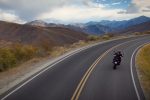
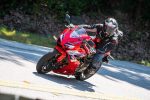

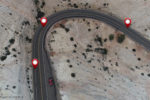
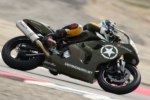
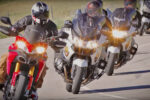
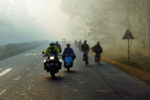
Dave, I am new to your content and I love how logic and rational you are when explaining thing. It really builds up credibility and trustworthiness for us riders who want to improve. Thanks!
Please show the proof that MSF’s Slow Look Press and Roll has as you stated, ” Slow, Look, Press and Roll is wrong. Flat out. It should never be taught as a riding technique. It’s been getting people hurt and killed since the idea was first published in the ‘70s. ” as you put it. I know part of getting a video or article out is to sensationalize but as you know these are ways to introduce beginner students to setting up and getting through a turn. Maybe a more advanced rider would use a slightly different approach but for a beginner getting used to Slowing and getting in the right gear for a turn is a good thing. Looking through a turn as soon as possible is a good thing. Pressing or countersteering into the turn is correct. And rolling on to a maintenance throttle before opening up the throttle when you can see the exit is a good thing.
Have you ever taught a brand new rider to gently slow into a corner? No? I have. Lot’s and lots of ’em. The concept of SLPR its based on flawed (long disproven) physics and logic. Being on the gas isn’t required for a bike to be stable, you don’t turn with the rear tire, the rear tire doesn’t have more grip simply because it’s bigger, slowing does not make the bike run wide, slowing into a corner doesn’t bottom the forks if you hit a small bump, etc. Source: Motorcycle Dynamics: https://amzn.to/2MCuYvK
I deal with the consequences of that doctrine after they graduate that basic rider course, the number of basic rider course grads who come to me because they crashed trying to implement a flawed technique is much higher than most instructors are willing to accept, and their crashes are often dismissed as “they didn’t enter the corner slow enough.” Well, no kidding, they are new riders. How can they expect a new rider to understand the nuance between maintenance throttle and acceleration with one simple word “roll?” How can they expect a new rider to accelerate through a downhill corner? How can they expect a new rider to accelerate through an off-camber corner, or a decreasing radius corner? Or a downhill, off camber, decreasing radius corner? How can they expect a new rider to transition from acceleration to slowing while leaning? That’s a seriously tricky move, even for experienced riders, yet they expect the brand new rider to do much more complex and risky moves and claim its safer. Gently slowing gives riders, especially new riders, more time and more choices to deal with corners. Yet, somehow, gently slowing is deemed dangerous? Think about that. SLPR sets new riders up for fear and failure.
Meant the previous comment for Dave not Felipe. Nevertheless, I think that MSF’s method however flawed you think they are have helped many beginning students evolve into better riders and probably have saved more lives and reduced or prevented injuries. As an MSF graduate I eventually improved and incorporated trail braking, throttle blipping, and race craft when I explored the track environment. I believe the things I learned from MSF helped guide me in to being a better and safer rider.
Oh, absolutely and without a doubt, but just like we can both improve our own riding, Basic riding programs could improve their coaching methods. Remember, MSF isn’t the only game in town, some programs teach Slow, Look, Roll, Press, doubling down on being on the gas before you even tip in.
This article/video makes so much sense. I was taught SLPR and was using it routinely until the “Trail Braking” thing started becoming more prevalent a few years ago. I then realized I had been using sort of a combination of the two techniques for awhile. Then, I decided to really go all in on trail braking but recently I “hit a bump in the road” so to speak and need your input. I was on a low traffic country road approaching a 90 degree turn to the left I had corned at least dozens of times. I gently applied the front brake and just as I applied the brake I accidentally rolled on the throttle! It remains kind of a blur but I instinctively disengaged the clutch and the RPM’s raced. I somehow fully engaged the brake while the engine was racing and managed to stay upright. I got the situation under control and I was at a complete stop at the entrance to the curve and was saying to myself “what the f#@$ just happened.” I told myself that IF I had let the clutch out the bike would have shot out from under me, or into the rough with me on it. Scary. Okay, nothing bad happened except I realized I needed some input. Based on this experience, a lesson was learned and I needed some advice. Finally, I’ve taken advanced cornering and u-turn clinics from Team Oregon and a half-day BMW Authority class on slow speed maneuvering, so I’m way beyond being critiqued adversely. Thanks for reading and I hope you reply.
Well, it sounds like you know exactly what happened. You whiskeyed’ the throttle, but then squeezing the clutch and letting things settle kept it from getting worse. A common cause of adding throttle while braking can be your wrist is too high on the handlebars, or you might be braking with your middle and ring finger, leaving your pointy finger on the throttle.